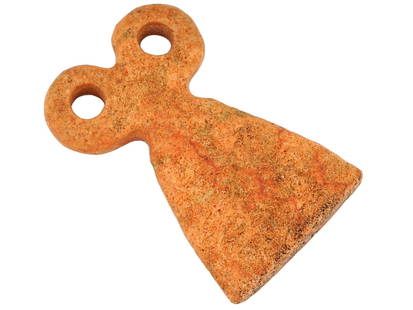
Western Asiatic Tell Brak Eye Idol
Similar Sale History
View More Items in Figurines & StatuettesRelated Figurines & Statuettes
More Items in Figurines & Statuettes
View MoreRecommended Decorative Objects
View More


Item Details
Description
3rd millennium BC. An alabaster bifacial idol, flat in section, with trapezoidal body and two large pierced and rimmed eyes above. 20 grams, 34mm (1 1/4"). Ex Rihani family collection; acquired 1980s. Today the remains of Tell Brak covers a massive forty-hectare area. It was first excavated by Max Mallowan in 1937-1938 when he found the remains of early religious practices represented by hundreds of votive objects, including the so-called 'eye idols'. Tell Brak must be considered as one of the oldest cultural sites in the world it was still in use during the Mitannian empire [1,500 - 1,360 BC]. During the Hellenistic and Roman eras, the site lay silent. Tell Brak was known as Nagar in Antiquity. Although they date from roughly 3200 BC, eye idols look remarkably modern. Simple and abstract, they represent the human form with a flat trapezoidal body and oversized eyes. Hundreds of these figurines were found in a monumental building known as the 'Eye Temple' in Tell Brak, north-eastern Syria. The idols vary in size from about 3 to 6 cm in height, and are made of either white or black alabaster. Because of the huge numbers of idols found, the monumental building where they were found has been called the 'Eye Temple.' The interior decoration was lavish - the altar was decorated with a frieze made from colourful stones, silver nails and gold foil, and on the floor and walls were mosaics made from coloured clay cones. Eye imagery and designs are found in the frieze and carvings in the temple, suggesting that the eye was a powerful magical and religious symbol. The large number of eye idols found and their size suggests that they were left in the temple as votives (gifts to the gods), perhaps representing the people who dedicated them as offerings. The decoration of the idols varied, and it seems that they may have been personalised; those on display in the Fitzwilliam are examples of the simplest type, but others have carved lines and zig-zags on their bodies depicting clothes. There are even examples of group idols representing more than one figure - some of which have a smaller 'child' figure carved onto the front. Eye Idol from Tell Brak (WAE.5.1966) Although Tell Brak is in north-eastern Syria, both the decoration and plan of the Eye Temple resemble that of south Mesopotamian temples, such as those in Uruk and Eridu. Eye symbolism was also popular in Mesopotamia around this time, and eye designs have been found on objects from the Royal Cemetery from Ur as well as in temples. The eye idols of Tell Brak, however, are completely unique and have no parallels, in either Syria or Mesopotamia. For more information: D. Collon, Ancient Near Eastern Art (London, 1995), 47, fig. 26. M.E.L. Mallowan, Excavations at Tell Brak, Iraq 9 (1947), 32-8; 150-9; 198-210.
Condition
Very fine condition.
Buyer's Premium
- 27%
Western Asiatic Tell Brak Eye Idol
Estimate £200 - £300
4 bidders are watching this item.
Shipping & Pickup Options
Item located in London, ukSee Policy for Shipping
Payment

TOP





















































































